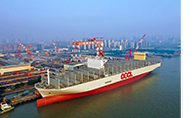A new compass for global shipping: Why smaller ships may steer the future
 The maritime industry is entering a new era—one defined not by scale, but by agility, sustainability, and regional relevance. Mega ships will still have their place on high-volume lanes, but the real growth lies in the feeder fleet renaissance. The maritime industry is entering a new era—one defined not by scale, but by agility, sustainability, and regional relevance. Mega ships will still have their place on high-volume lanes, but the real growth lies in the feeder fleet renaissance.
Charterers may well rethink their strategies, balancing short-term cost efficiency with long-term regulatory and operational resilience. Shipbuilders must pivot toward smarter, greener vessels that can thrive in a fragmented and fast-evolving trade landscape.
This shift comes as global trade realigns itself - not just economically, but politically and environmentally.
For nearly two decades, container shipping has favoured mega vessels designed to optimise economies of scale and carry upward of 20,000 TEU between major global ports. These vessels are architectural marvels and financial powerhouses - capable of transporting vast cargo loads across oceans with fewer trips and lower unit costs. However, that dominance is now being questioned.
The cracks are appearing at several levels. Many hub ports already strain to accommodate these giants, and expanding infrastructure to support even larger ships presents logistical, financial, and environmental hurdles.
Increasingly stringent emissions regulations, including IMO’s CII and EEXI as well as the EU’s FuelEU Maritime and ETS mandates, are forcing operators to reconsider vessel viability. Retrofitting mega ships for compliance is costly and sometimes technically unfeasible.
Meanwhile, charterers are reassessing long-term contracts tied to vessels that may become regulatory liabilities or operational bottlenecks. Flexibility - not size - is now a key asset.
Enter the feeder ship: smaller, nimbler, and more suited to evolving trade patterns. These vessels, typically under 4,000 TEU, are gaining prominence in connecting secondary ports and enabling regional distribution. With intra-Asia trade growing and sourcing shifting away from China toward India, Vietnam, and Indonesia, feeder services are becoming integral to supply chain agility.
They're also crucial for solving a persistent challenge—the backhaul dilemma. A substantial number of containers return empty, burning fuel and money while contributing nothing to trade. Feeder vessels, with their ability to support diverse cargo flows and access underserved ports, offer a more dynamic solution for balanced two-way traffic.
Charterers are increasingly seeking vessels that not only navigate these nuanced logistics but also meet evolving environmental standards. Demand is rising for ships powered by dual-fuel engines -methanol, LNG, or ammonia-ready - allowing flexibility in fuel choices as global infrastructure catches up.
According to market intelligence from Clarksons Research and Braemar, newbuild orders for small container vessels have surged. More than 30 per cent of feeder ships ordered in 2025 include dual-fuel or hybrid systems. Many incorporate design features such as wind-assisted propulsion, battery storage, and shore power compatibility.
The aging of the global feeder fleet is another accelerant. More than 30 per cent of small feeders are over two decades old, and nearly half will reach that threshold by 2030. Replacing them isn't just a strategic choice—it’s becoming a necessity.
Against this backdrop, broader economic trends add further dimension to the story.
While the United States continues to show resilience - buoyed by infrastructure investments, healthy consumer demand, and trade flow diversification - the same cannot be said for its Western counterparts. Canada, Australia, the EU, and the UK have taken a path that prioritises environmental stability over economic expansion. These “slow-growth by design” economies are crafting policies that restrict fossil fuel use, tighten emissions limits, and, inadvertently, suppress shipping volumes.
It’s a tension few in the industry expected: fighting climate change while keeping supply chains fluid and efficient. Bulk commodities - coal, iron ore, grains - are particularly vulnerable. While demand from Europe is waning, China and India are stepping up, bolstering volumes with industrial expansion and infrastructure buildouts. Their appetite for dry bulk, LNG, and containerized cargo suggests continued growth - even as the West pulls back.
But even among growth stories, the shape of the shipping response is changing. It's no longer just about what goods are being moved - but how and where. Regionalisation of trade, rise of nearshoring, and the push toward digital port operations are collectively fueling demand for versatile, small-to-medium sized ships.
Shipbuilders are adjusting their portfolios in response. South Korean and Chinese yards are leading the charge, focusing on flexible tonnage equipped with smart navigation systems, carbon monitoring tech, and future-ready fuel infrastructure. Modular construction techniques are shortening build times and reducing retrofit costs. Intelligence layering, using AI, automation, and predictive logistics, is transforming both the construction and operation of vessels.
In this landscape, charterers and shipbuilders aren’t just responding to immediate market forces, they’re preparing for a future where green regulation, geopolitical risk, and fuel volatility drive every decision. The winners will be those who build vessels not just for today's routes, but for tomorrow’s uncertainties.
It’s clear now: the maritime world is moving away from uniformity and toward customisation and compliance. The feeder fleet is no longer a support act - it’s becoming the star of the show.
And in a time when global trade is increasingly fragmented, the ability to adapt - to be smaller, smarter, and cleaner - is the key to staying afloat. |